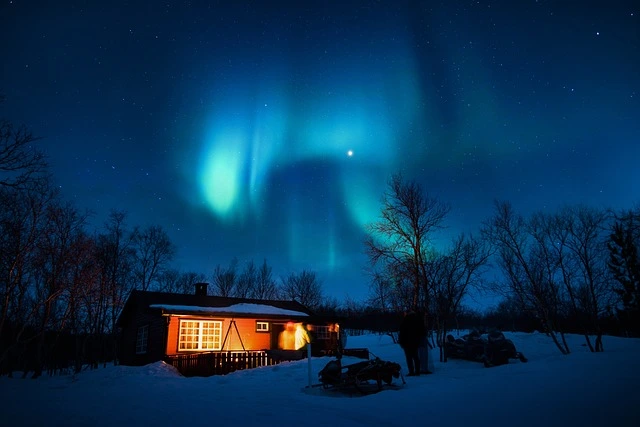Why Is the Sky Blue in Color
Why Is the Sky Blue in Color
Have you ever looked up at the sky and wondered why it appears so beautifully blue? The answer lies in the fascinating world of light and colors. In this article, we will take a journey through the science behind the blue hue of the sky and discover the factors that contribute to this captivating phenomenon. So, let’s dive in and explore the enchanting secrets of the sky’s color.

The sky, with its vastness and ever-changing colors, has captivated humans for centuries. Artists, poets, and scientists have all marveled at its beauty. But what exactly causes the sky to appear blue? Join us as we unravel the mysteries and delve into the science behind this captivating phenomenon.
Understanding Light and Colors

To comprehend why the sky is blue, we must first understand the nature of light and how it interacts with our surroundings. Light consists of different wavelengths, each associated with a specific color. When light encounters an object, it can be absorbed, transmitted, or scattered. These interactions play a crucial role in revealing the secrets behind the blue color of the sky.
The Scattering of Light
One of the key processes contributing to the coloration of the sky is the scattering of light. When sunlight reaches the Earth’s atmosphere, it interacts with the particles present, causing the light to change direction. This phenomenon is known as scattering. Among the different types of scattering, one called Rayleigh scattering is primarily responsible for the blue color of the sky.
Rayleigh Scattering
Rayleigh scattering occurs when the particles in the atmosphere, such as nitrogen and oxygen molecules, are much smaller than the wavelength of light. When sunlight passes through the atmosphere, it scatters more easily with shorter wavelengths, such as blue and violet, compared to longer wavelengths like red and orange. As a result, the blue light is scattered in all directions, giving the sky its characteristic blue appearance.
Blue Light and the Sky

The reason the sky appears blue to our eyes is because we are more sensitive to shorter wavelengths of light, particularly blue. As sunlight travels through the Earth’s atmosphere, the blue light is scattered in all directions and reaches our eyes from every angle. This scattered blue light dominates our perception, making the sky above us appear blue during daylight hours.
The Role of the Atmosphere
The composition and properties of Earth’s atmosphere play a crucial role in determining the color of the sky. The abundance of particles, such as dust, pollutants, and water vapor, can affect the scattering process and influence the intensity and shade of the blue color. This is why the sky may appear lighter or darker depending on atmospheric conditions.
The Color of Sunsets and Sunrises
While the sky is predominantly blue during the day, the colors we witness during sunrise and sunset are a result of a different scattering phenomenon. During these times, the sun is positioned at a lower angle in the sky, causing sunlight to travel through a thicker layer of the atmosphere. This scattering, known as Mie scattering, scatters longer wavelengths, such as red, orange, and yellow, creating the vibrant colors we associate with sunsets and sunrises.
Factors Affecting the Sky’s Color
Various factors can influence the perceived color of the sky. Atmospheric conditions, such as pollution, dust, and humidity, can alter the scattering of light and affect the hue of the sky. Additionally, altitude and location play a role, as different parts of the world have varying levels of atmospheric particles and moisture content.
Other Colors in the Sky
While the sky is commonly associated with its iconic blue color, it can exhibit other hues under specific conditions. During storms, the sky can appear gray due to dense cloud cover and the scattering of light by water droplets. Moreover, phenomena like the Northern Lights can create mesmerizing displays of colors, painting the night sky with vibrant greens, pinks, and purples.
Sky Colors on Other Planets
The color of the sky is not exclusive to Earth. Other celestial bodies, such as Mars and Venus, also possess their unique sky colors. Mars, known as the “Red Planet,” exhibits a dusty atmosphere that scatters light, giving its sky a reddish tint. Venus, on the other hand, has a dense atmosphere dominated by carbon dioxide, causing its sky to appear yellowish-white.
The Sky’s Influence on Human Perception
The color of the sky has a profound impact on human perception and emotions. Research suggests that exposure to blue light can enhance cognitive performance, improve mood, and increase alertness. The calming effect of the blue sky has even been linked to reduced stress levels and improved mental well-being.
Symbolism and Cultural Significance
The sky’s color holds symbolic and cultural significance across different societies and civilizations. Blue skies often represent tranquility, optimism, and freedom. In art, literature, and religious texts, the sky has been depicted as a symbol of hope, divinity, and vastness. Its color has influenced human imagination and storytelling throughout history.
Scientific Research and Discoveries
Scientists continue to study the intricacies of the sky’s color, employing advanced techniques and instruments to unravel its mysteries. Their research expands our understanding of light, atmospheric phenomena, and the intricacies of our universe. Each discovery contributes to a more comprehensive picture of why the sky appears blue and enriches our knowledge of the world we inhabit.
Sky Color and Weather Forecasting
Observing the color of the sky is not only aesthetically pleasing but can also provide valuable information for weather forecasting. Variations in the sky’s color, such as the appearance of certain clouds or shifts in hue, can indicate changes in atmospheric conditions. Meteorologists rely on these visual cues to predict weather patterns and issue forecasts.
Conclusion
The blue color of the sky is a captivating marvel that has fascinated humanity for centuries. Through the scattering of sunlight by particles in the Earth’s atmosphere, the sky paints itself in vibrant shades of blue. Understanding the science behind the sky’s color enhances our appreciation of the natural world and reminds us of the beauty and complexity that surround us.
FAQs
Why does the sky appear blue?
The sky appears blue because of a phenomenon called Rayleigh scattering, where shorter wavelengths of light, such as blue and violet, scatter more easily in the Earth’s atmosphere.
Can the color of the sky change?
Yes, the color of the sky can change based on atmospheric conditions, such as pollution, dust, and humidity. It can appear lighter or darker, and different colors may be visible during sunsets and sunrises.
Why does the sky turn red during sunsets?
During sunsets, the sun is positioned at a lower angle, causing sunlight to travel through a thicker layer of the atmosphere. This leads to a different scattering phenomenon called Mie scattering, which scatters longer wavelengths, such as red, orange, and yellow, creating the red hues during sunsets.
Do other planets have different sky colors?
Yes, other planets have different sky colors. For example, Mars has a reddish sky due to the scattering of light by dust particles in its atmosphere, while Venus has a yellowish-white sky caused by its dense carbon dioxide atmosphere.
Does the color of the sky affect human emotions?
The color of the sky, particularly blue, can have a positive impact on human emotions. Exposure to blue light has been linked to improved mood, increased alertness, and reduced stress levels. The calming effect of the blue sky can promote a sense of well-being and tranquility.
Read These Interesting Post Also
Best 8 Tips on How to buy a mobile phone
MOTOROLA Edge 40 – Flagship Smartphone
How to take screenshot in laptop window 7
Revolutionizing Productivity: 5 Must-Have AI Tools for Every Task
How to Earn Money Online Without Investment in Mobile
How a Son of an Autorickshaw Driver Became Youngest IAS Officer of India
